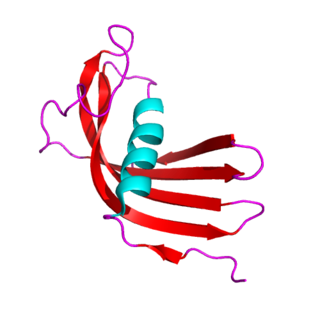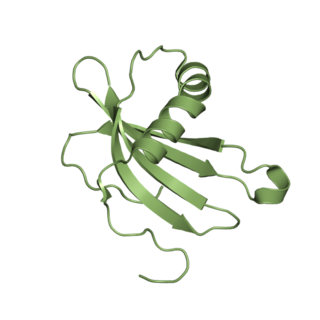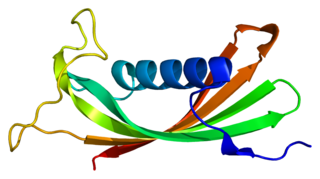Cathepsin L1 is a protein that in humans is encoded by the CTSL1 gene. [3] [4] [5] The protein is a cysteine cathepsin, a lysosomal cysteine protease that plays a major role in intracellular protein catabolism. [6] [7] [8] [9]
Cathepsin L1 is a protein that in humans is encoded by the CTSL1 gene. [3] [4] [5] The protein is a cysteine cathepsin, a lysosomal cysteine protease that plays a major role in intracellular protein catabolism. [6] [7] [8] [9]
Cathepsin L1 is a member of the Peptidase C1 (cathepsin) MEROPS family, which plays an important role in diverse processes including normal lysosome mediated protein turnover, antigen and proprotein processing, and apoptosis. [10] Its substrates include collagen and elastin, as well as alpha-1 protease inhibitor, a major controlling element of neutrophil elastase activity. The encoded protein has been implicated in several pathologic processes, including myofibril necrosis in myopathies and in myocardial ischemia, and in the renal tubular response to proteinuria. This protein, which is a member of the peptidase C1 family, is a dimer composed of disulfide-linked heavy and light chains, both produced from a single protein precursor. At least two transcript variants encoding the same protein have been found for this gene. [5]
Cleavage of the SARS-CoV-2 S2 spike protein required for viral entry into cells can be accomplished by proteases TMPRSS2 located on the cell membrane, or by cathepsins (primarily cathepsin L) in endolysosomes. [11] Hydroxychloroquine inhibits the action of cathepsin L in endolysosomes, but because cathepsin L cleavage is minor compared to TMPRSS2 cleavage, hydroxychloroquine does little to inhibit SARS-CoV-2 infection. [11]
Although Cathepsin L is usually characterized as a lysosomal protease, it can be secreted, resulting in pathological inflammation. [12] Cathepsin L and other cysteine cathepsins tend to be secreted by macrophages and other tissue-invading immune cells when causing pathological inflammation. [13]
CTSL1 has been shown to interact with Cystatin A. [14] [15]
Cathepsin L has been reported in many organisms including fish, [16] birds, mammals, and sponges. [17]

Cathepsin S is a protein that in humans is encoded by the CTSS gene. Transcript variants utilizing alternative polyadenylation signals exist for this gene.

Cathepsin O is an enzyme that in humans is encoded by the CTSO gene.

The cystatins are a family of cysteine protease inhibitors which share a sequence homology and a common tertiary structure of an alpha helix lying on top of an anti-parallel beta sheet. The family is subdivided as described below.

Cathepsin B belongs to a family of lysosomal cysteine proteases known as the cysteine cathepsins and plays an important role in intracellular proteolysis. In humans, cathepsin B is encoded by the CTSB gene. Cathepsin B is upregulated in certain cancers, in pre-malignant lesions, and in various other pathological conditions.

Cathepsin D is a protein that in humans is encoded by the CTSD gene. This gene encodes a lysosomal aspartyl protease composed of a protein dimer of disulfide-linked heavy and light chains, both produced from a single protein precursor. Cathepsin D is an aspartic endo-protease that is ubiquitously distributed in lysosomes. The main function of cathepsin D is to degrade proteins and activate precursors of bioactive proteins in pre-lysosomal compartments. This proteinase, which is a member of the peptidase A1 family, has a specificity similar to but narrower than that of pepsin A. Transcription of the CTSD gene is initiated from several sites, including one that is a start site for an estrogen-regulated transcript. Mutations in this gene are involved in the pathogenesis of several diseases, including breast cancer and possibly Alzheimer disease. Homozygous deletion of the CTSD gene leads to early lethality in the postnatal phase. Deficiency of CTSD gene has been reported an underlying cause of neuronal ceroid lipofuscinosis (NCL).

Cystatin-A is a protein that in humans is encoded by the CSTA gene.

Cystatin-B is a protein that in humans is encoded by the CSTB gene.

Cathepsin H is a protein that in humans is encoded by the CTSH gene.

Cystatin-S is a protein that in humans is encoded by the CST4 gene.

Cystatin-SN is a protein that in humans is encoded by the CST1 gene.

Cystatin-SA is a protein that in humans is encoded by the CST2 gene.

Cystatin-M is a protein that in humans is encoded by the CST6 gene.

Cystatin-F is a protein that in humans is encoded by the CST7 gene.

Cystatin-D is a protein that in humans is encoded by the CST5 gene.

Cathepsin Z, also called cathepsin X or cathepsin P, is a protein that in humans is encoded by the CTSZ gene. It is a member of the cysteine cathepsin family of cysteine proteases, which has 11 members. As one of the 11 cathepsins, cathepsin Z contains distinctive features from others. Cathepsin Z has been reported involved in cancer malignancy and inflammation.

Cathepsin L2 is a protein encoded in humans by the CTSV gene.

Cathepsin W is a protein that in humans is encoded by the CTSW gene.

Serpin B13 is a protein that in humans is encoded by the SERPINB13 gene.

Cathepsin F is a protein that in humans is encoded by the CTSF gene.
Myeloid and erythroid nuclear termination stage-specific protein (MENT) is a member of the serpin family of protease inhibitors, and participates in DNA and chromatin condensation. Alongside its ability to condense chromatin, MENT is also an effective inhibitor of the proteases cathepsin K, cathepsin L, and cathepsin V, all of which are cysteine proteases. As such, although MENT is structurally classified as a member of the serpin family, it is functionally termed a "cross-class inhibitor," as it is a cysteine rather than a serine protease inhibitor.